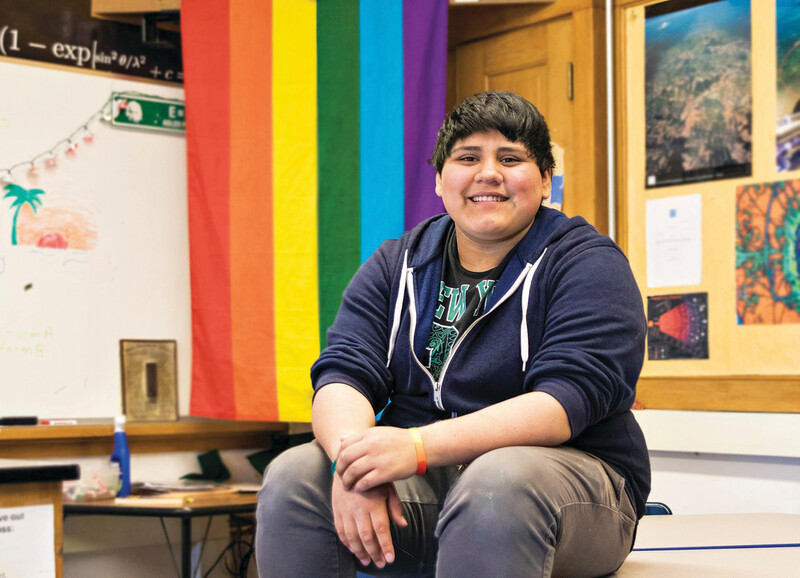Over the past year, news coverage and public discussions about transgender people and identities have increased dramatically. For educators, the discussion became more urgent and professionally relevant in May 2016 when the U.S. Department of Justice and the U.S. Department of Education issued guidance designed to ensure that transgender students are treated with dignity in every public and federally funded school across the United States. Although many courts have held that transgender students are protected under Title IX from discrimination on the basis of gender identity, several states filed lawsuits objecting to the federal government's enforcement of the guidelines. In August, a federal judge in Texas issued a temporary injunction to stop the Obama administration from enforcing the May directive.
But the transgender students in our schools cannot wait for courts to uphold their rights. The injunction does not stop schools from following inclusive practices for trans youth.
As the head of the Children, Youth, and Families Program at the Human Rights Campaign (HRC), I saw an immediate spike in calls and e-mails from educators after the guidance was initially released. They were eager to learn more about how to fully implement the best LGBTQ-inclusive practices. Many of their questions, I'm sure, mirror your own.
The guidance outlines the rights of transgender students under longstanding federal civil rights laws, including two key concepts most relevant to educators: safety and inclusion. As educators dedicated to the success of every child, we are now called to extend our best efforts to support transgender students and provide safe and inclusive school environments, regardless of our own level of experience, knowledge, or comfort with transgender people.
Even as more school districts adopt policies to protect transgender students, and courts rule in favor of transgender students' rights to use restrooms and locker rooms that correspond to their gender identity, these students are still struggling for basic acceptance. They continue to experience high rates of harassment, bullying, and other types of in-school victimization, including verbal or physical assault by peers and humiliation by educators refusing to use the correct pronouns.
The harmful effects can't be ignored. According to research by Caitlin Ryan and colleagues (2009), young LGBTQ people facing significant rejection are eight times more likely to attempt suicide than their non-LGBTQ peers. I don't share this statistic to create fear or drama, but rather to emphasize the significant role every adult plays in the lives of transgender students and the life-saving difference we can make if we are supportive and accepting.
The Gay, Lesbian, & Straight Education Network's (2013) school climate survey found that, compared with lesbian, gay, and bisexual students, transgender students faced the most hostile environments. Among transgender youth surveyed, 42 percent had been prevented from using their preferred name, 60 percent had been forced to use a bathroom or locker room that corresponded with the sex listed on their birth certificate rather than their gender identity, and 30 percent had been barred from wearing clothes consistent with who they are. Such discrimination can undoubtedly have significant consequences for students' social and emotional well-being, as well as their academic performance.
The Department of Education's guidance is intended to reduce the hostility and marginalization that so many transgender students face and to provide concrete answers to administrators and educators eager to enact policies and practices that ensure every transgender students' dignity and safety.
Understanding What Transgender Means
Having a better understanding of what it means to be transgender or gender non-binary is essential to implementing changes. This begins with using language related to the transgender community in a respectful and accurate way that helps students trust you and feel safe.
Gender identity refers to a person's innermost sense of being male or female, or in some cases, neither or both. Gender expression refers to the way a person manifests gender identity externally, for example through clothing, hairstyle, or behavior; gender expression can be masculine, feminine, or androgynous.
Biological sex, or the preferred term sex assigned at birth, is the declaration we make when a baby is born on the basis of the appearance of external genitalia. For most people, that declaration will align with their gender identity. The word that describes people with this experience is cisgender. For some people, however, their assigned sex at birth does not align with their gender identity. The term for people with this experience is transgender. It is acceptable to use the term trans, but not transgendered, which suggests that something was done "to you."
To transition means to take steps to align your body and appearance to your inner gender identity. Not all trans people will travel the same path; transition can occur gradually or quickly and may or may not include a name change, hormone therapy, or surgeries. Young students may socially transition by adopting a name and pronouns that match their gender identity and wearing clothing and hairstyles that express their identity. Older students may begin taking hormones to prevent the development of secondary sex characteristics in adolescence.
Decisions about gender transition are deeply personal. It's up to students and their families to decide what and when to share that information.
Being transgender does not mean the same thing or feel the same way to all people. Among teens in particular, the experience of gender identity is expanding. Those identities include genderqueer, gender fluid, agender, non-binary, and androgynous, to name a few. For simplicity's sake, we can cluster these "other" gender identities into the category of non-binary, which includes people who don't identify as either male or female. Some non-binary students may engage in aspects of gender transition. For instance, a non-binary student may prefer the pronoun "they/them" or ask that you not use pronouns at all.
The important takeaway is that young people are challenging the gender binary notion that one must be either male or female—and it's up to us to allow space for students to tell us and show us who they are, rather than making assumptions on the basis of a name, clothing, voice, or other attributes we typically associate with gender. In other words, follow your students' lead of how they self-identify and respond by affirming and respecting that identity.
First and Lasting Impressions
Efforts to create safe and inclusive schools for transgender students apply across the K–12 continuum. According to the American Academy of Pediatrics (2015), gender identity is established by age 4. For the relatively small percentage of children who have a "boy brain but a girl body," as one young transgender boy described it, these feelings can be present at the start of preschool, though children's awareness and understanding of being transgender may emerge at any time during the K–12 years. Including and welcoming transgender students is not just a concern for middle or high schools, but for elementary schools, too. The approach to how we educate and support students and families differs, of course, depending on the age level you teach.
No matter the grade level, first impressions matter. On my older daughter's first day of kindergarten nearly 12 years ago, the teacher went to great lengths to decorate the classroom with colorful posters, book displays, and a big welcome board outside the classroom door. On the board were 26 figures of a cute bear, each one with either a blue bow tie or pink hair bow and a student's name. The teacher assigned a bear to each student solely on the basis of the names and genders listed on her roster, without any knowledge of how the children experienced or expressed their gender.
As a then-40-year-old androgynous woman, standing with my 5-year-old girl, I personally had a negative reaction to the bears. I knew that if I were in that kindergarten class, I would have looked at my bear—with my name and a pink bow—and felt as if I wanted to disappear. Like many girls, I never chose pink bows, and I know there are many boys who don't gravitate toward blue bow ties.
The kindergarten teacher was a lovely woman—kind, engaging, and skilled, and she certainly meant the welcome board to be a gesture of inclusion. Like her, many educators are unaware of the unconscious ways in which we reinforce gender expectations and stereotypes that unintentionally marginalize transgender students and those who are not rigidly gender-conforming. Of course missteps will happen—we are only human—and a swift step to correct and improve future interactions is the best remedy.
How to Foster a Culture of Inclusion
Because we don't necessarily know who is cisgender and who is transgender, the first step to cultivating an inclusive culture is to get out of the habit of making assumptions. If you don't know someone's pronouns, it's best to ask rather than assigning the wrong ones. Transgender students are frequently "misgendered" by others, sometimes by mistake and sometimes with intention. Either way, this is an extremely negative experience for trans students.
We also make assumptions on the basis of gender roles and stereotypes, including assumptions that girls and boys will prefer certain toys or activities. Not only can educators examine their own assumptions, but we can also take a proactive role and speak up if we hear a student declare, "Girls don't play football." We can teach our students that there is no such thing as a "boy color."
Likewise, in many classrooms, it is common practice to line up students or assign them to activities using gender—"Boys line up here, girls line up here." Why not line up students on the basis of the month of their birthday? With a little creativity and willingness to break old habits, we can help students breathe more easily.
Creating a Safe Space
Your use of respectful language and behavior with transgender students will model for all students the expectation for civil behavior. If you hear others using derogatory or hurtful language, step in to stop it. Do not ask personal questions about the student's transition, their anatomy, or any medical issues. Use the name and pronoun that matches the student's gender identity even if the legal name on the school record is different, and keep the information about their prior name and pronoun confidential.
Some transgender students are out to the entire school community, particularly those who transition during the school year. Others may transition before starting a new school year, and perhaps only a few people have been told—a school nurse, principal, or homeroom teacher. If a student is out as transgender to you, keep that information confidential. Trans students face a very high risk of physical harm if they are "outed."
Finally, whether or not you know of transgender students, any of your students may be questioning their gender identity, and all of your students will be living in a world that includes transgender people. You have an opportunity to speak with respect about trans people and to intervene—to create a teachable moment—if your students are unkind.
Whole-School Approach
The entire school community must be committed to creating a welcoming, inclusive environment for transgender students. Educating educators is essential, but it's also important to inform parents, support staff, and other students. School counselors, nurses, and psychologists need to be competent in providing services and resources to trans students and their families.
Principals can schedule a professional development workshop on transgender inclusion. We have found that some of the most influential and compelling presenters on this topic are parents of trans children, many of whom have had to navigate sticky situations at school and have great insight into what schools can do better. There are wonderful resources online, including a guide called Schools In Transition: A Guide for Supporting Transgender Students in K–12 Schools, which was copublished by the HRC, the National Education Association, and several other national organizations. The HRC Welcoming Schools program also offers a whole-school approach—including structural, relational, and instructional suggestions.
Moving Forward
Imagine you are a child who was assigned male at birth but by age 3 you feel certain you are a girl; you reject boys' clothing, you want to play with other girls and grow your hair long, but your body does not reflect who you are. This is the experience of Ellie, a 5-year-old transgender girl in Washington, D.C., who, with the support and guidance of her parents, socially transitioned in preschool. In a letter to Ellie's teachers, her parents wrote,
Ellie is the name our child chose when she worried people would think she was a boy with a name like Zack. Ellie has told us she's a girl in many ways. The clearest way has been, "I am a girl in my heart and in my brain." This is the way our child was born, and we love her. Thank you for your support.
For many of us, learning about what it means to be transgender and stepping up as an ally for transgender inclusion might take some work. We all have preconceived ideas and beliefs about gender, and we are being asked to step out of what might have been our comfort zone. But Ellie's parents are counting on educators like you to support their child and keep her safe.
The ability to imagine how it would feel to not be seen by others as who you truly are is an essential first step to being a leader for transgender inclusion. Empathy is key.
By gaining knowledge about the transgender experience, using the correct language and terminology, and speaking with respect and kindness to and about our transgender students, you—as an educator and an ally—can dramatically shift the school climate to one that is safe, supportive, and inclusive: a place where all students can learn, achieve, and thrive.









